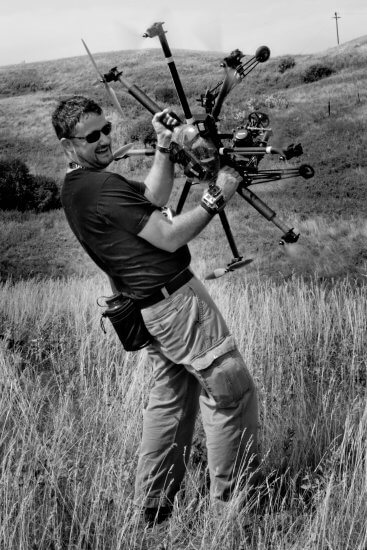MAIS learner tells stories about science
Dave Blaine is a scientific storyteller. Or a storytelling scientist, if you prefer.

However you frame it, what he wants out of the Master of Arts in Interdisciplinary Studies (MAIS) program at Athabasca University (AU) is to be able to more effectively tell the story of the on-the-ground work scientists do in a multimedia format.
With a professional background as a photographer, videographer, and geographic information system (GIS) specialist—along with a passion for archeology that dates back to his undergraduate degree in the early 2000s—he’s now working with the Stann Creek Regional Archaeology Project (SCRAP) led by AU Associate Professor Dr. Meaghan Peuramaki-Brown.
“I think there’s a need for this in archeology, and more broadly in the social sciences, to say this is the kind of thing we do,” Blaine said. “That’s what I wanted to bring to the table using my background in visual communications, but also really developing skill in digital technologies because this is how we’re going to get our word out.”
His goal will be much easier to achieve thanks to a large scholarship. Earlier this year he was awarded the Joseph Armand Bombardier Canada Graduate Scholarship from the Social Sciences and Humanities Research Council of Canada (SSHRC), which includes an award of $17,500 over 12 months.
He got involved with SCRAP as a result of a personal interest in archeology, rather than a professional one. After completing a bachelor of arts in archeology from the University of Calgary in 2002, his career path took him away from archeology.
““The project is more than just ‘the dig,’ so the story we tell has to be about more than just the research. It should share the richness and nuance of all the culturally distinct communities we get to live and work in.”
– Dave Blaine, MAIS learner
Blaine operates a small business providing photography and videography services, and has also completed a bachelor of technology in GIS from the Southern Alberta Institute of Technology. He currently works in that field, but his interest in archeology never went away and he stayed connected with the archeology community.
“I always wanted to get back into archeology,” he said. “I would go to the annual archeology conference at the University of Calgary, just to keep my feet in the water and see what’s happening.”
It was there Blaine reconnected with Peuramaki-Brown; they had graduated from their undergraduate degrees together, but didn’t become friends until later. Given his background in visual communications, he was able to convince her of the benefit of his expertise and has now become part of the SCRAP project team. It was her who suggested he look at the MAIS program at AU, given the diverse approaches he takes to communicating.
In terms of his inspiration in communicating science to the general public, he said he looks to Dr. Neil deGrasse Tyson’s Cosmos. In particular, he said he was inspired by the way deGrasse Tyson can break down complicated scientific information in a way that’s fun and accessible.
This is something Blaine said he’s optimistic he can do, and do well, given the subject matter he’s working with as part of SCRAP is one of the science topics that’s most interesting to the general public.
“As far as science communication goes, you’ve got dinosaurs, you’ve got space, and you’ve got lost cities,” he said. “The work is practically done for us; it’s not like we have to craft a hook to make people pay attention.”
Although Blaine said it’s important to be able to communicate the work the scientists are doing as part of the SCRAP project, he also emphasized the importance of representing the host communities where small- and large-scale projects like archeology excavations take place.
In the case of SCRAP, for example, the team works in Belize with community members who live modern lives in the present in the place where scientists and local knowledge experts are studying the past—and in some cases, these community members may be descended from the cultures and societies being studied.
“The project is more than just ‘the dig,’ so the story we tell has to be about more than just the research,” Blaine said. “It should share the richness and nuance of all the culturally distinct communities we get to live and work in.”
“As far as science communication goes, you’ve got dinosaurs, you’ve got space, and you’ve got lost cities. The work is practically done for us; it’s not like we have to craft a hook to make people pay attention.”
– Dave Blaine, MAIS learner